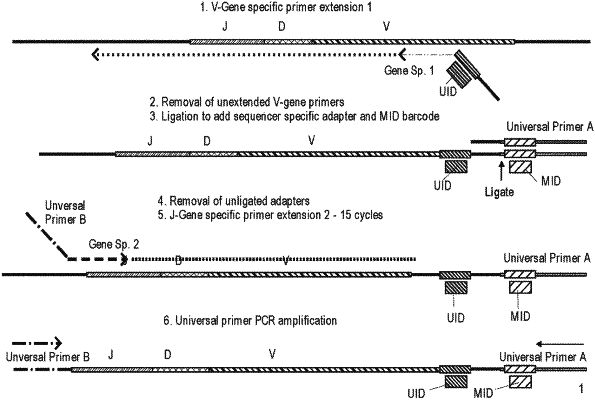| CPC C40B 50/06 (2013.01) [C12N 15/1065 (2013.01); C12Q 1/68 (2013.01); C12Q 1/6881 (2013.01); C12Q 1/6886 (2013.01); C12Q 2600/16 (2013.01)] | 19 Claims |

|
1. A method for enriching a sample for a plurality of structurally different target polynucleotides comprising an immune gene sequence the method comprising:
a) contacting a sample with a plurality of immune cell receptor V gene specific primers, each primer including from 5′ to 3′: [SPLINT1], [BARCODE], and [V], wherein: [SPLINT] is a first adaptor sequence; [BARCODE] is a unique molecular identifier barcode; and [V] is a sequence capable of hybridizing to an immune cell receptor V gene;
b) hybridizing and extending the V gene specific primers to form a plurality of first double-stranded primer extension products;
c) contacting the sample with an exonuclease to remove unhybridized V gene specific primers from the first double stranded primer extension products;
d) contacting the sample with a plurality of immune cell receptor J gene specific primers, each primer including from 5′ to 3′: [SPLINT2], and [J], wherein: [SPLINT2] is a second adaptor sequence; and [J] is a sequence capable of hybridizing to an immune cell receptor J gene; and further contacting the sample with a first universal primer capable of hybridizing to the first adaptor sequence;
e) hybridizing and extending the J gene specific primers and the first universal primer to form a plurality of second double-stranded primer extension products;
f) contacting the sample with an exonuclease to remove unhybridized J gene specific primers and first universal primer from the second double-stranded primer extension products;
g) contacting the sample with first and second universal primers capable of hybridizing to the first and second adaptor sequences;
h) amplifying the plurality of second double-stranded primer extension products thereby enriching the plurality of structurally different target polynucleotides comprising an immune gene sequence.
|